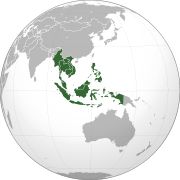US Pivots To Maritime Southeast Asia – Analysis
By RSIS
The United States decision to deploy littoral combat ships in Singapore signals a maritime focus in its pivot to the Asia-Pacific. It reaffirms U.S. commitment to support Southeast Asian allies and partners amid China’s growing maritime assertiveness in the region.
By Ristian Atriandi Supriyanto
THE UNITED STATES’ pivot to Asia comes with a maritime focus. The announcement made by then U.S. Secretary of Defense, Robert Gates, in June 2011 was to deploy the U.S. Navy’s newest warship, the Littoral Combat Ship (LCS) to Singapore. While Singapore is not the only place for LCS deployment (the others being Bahrain and Japan), it still signifies the prime importance accorded to Southeast Asia in the American geopolitical calculus. It conveys a specific political message of U.S. commitment to support Southeast Asian allies and partners, who are increasingly wary over Beijing’s growing maritime and military assertiveness. But to what extent is this view shared in the region?
Littoral Combat Ship

The LCS is designed for naval combat operations close to shore and specifically tailored to operate in anti-access and area denial environment mainly characterised by asymmetric capabilities, such as naval mines, fast attack craft, and diesel submarines. Given the amorphous nature of littoral warfare, the LCS has a “modular” design capable of “plug-and-play” to adapt into various operational requirements, such as mine warfare (MIW), anti-submarine warfare (ASW), and anti-surface warfare (ASuW).
Two designs of LCS have been developed by the USN, with a plan to acquire up to 60 units. The first LCS (LCS-1), commissioned as USS Freedom in November 2008, was built by the Lockheed Martin Corp. and featured a steel monohull with a displacement of 3,000 tonne. The second LCS (LCS-2) built by General Dynamics Corp. was commissioned as USS Independence in January 2010 with a trimaran design and slightly larger than the LCS-1. Both are capable to achieve a speed of over 40 knots and sail for up to 3,500 nautical miles. The warship’s shallow draft and highspeed make it suitable to operate in Asia’s complex and contested littoral environment.
Maritime Pivot
The LCS deployment was discussed by Singapore Defence Minister, Dr. Ng Eng Hen, and U.S. Defense Secretary Leon Panetta during the former’s visit to the Pentagon in April 2012. It was agreed that Singapore would host four LCS, though they would be deployed on a rotational basis and without any basing arrangements. The plan will commence gradually, with one or two ships in the first batch of 10-month deployment starting next year.
For any naval planners, Singapore represents an ideal springboard for maritime power projection. In the nineteenth century, for example, British First Sea Lord, Admiral John Fisher, defined Singapore as among the “Five keys [to] lock up the world” to emphasise its importance for the Royal Navy’s power projection. And now, from a strategic lens, the LCS deployment symbolically reflects Washington’s pivot to the Asia-Pacific.
Located at the heart of maritime Asia and crossed by the world’s busiest shipping lanes, Singapore presents a compelling geostrategic rationale. It gives the U.S. a central position along the Indo-Pacific rim, the so-called “geographical pivot” of the twenty-first century, defined mostly by interaction between the major powers. From an operational viewpoint, Singapore already provides facilities for the Command Logistics Group in Western Pacific (COMLOG WESTPAC), which could tend the LCS. The relatively small core crew members (over 40 sailors) required to man the LCS is also a gesture to Singapore’s concern with regional sensitivities and limited land space, which ruled out a heavy presence of American military personnel.
The decision to deploy the LCS, however, is only part of a broader U.S. Pacific strategy. Earlier this year, the U.S. sent the first batch of an eventual 2,500 marines to Darwin, Australia and stated its plan to increase naval and air presence, such as unmanned aerial vehicles (UAVs) and nuclear submarines, in Southeast Asia’s immediate environs, like the Cocos Islands, located just 1,000 kms southwest of Java.
The U.S. also reaffirmed its commitment to defend the Philippines under the Mutual Defense Treaty. While wary about being embroiled in conflicts because of the competing claims of China and the Philippines in the SCS, Washington slightly increased military aid to Manila to US$30 million in 2012 and pledged to equip the latter with another cutter, radar systems, and F-16 jet fighters.
Naval Diplomacy
The LCS deployment is a perfect example of navies being used as an instrument of foreign policy, also known as “naval diplomacy.” It has a symbolic meaning of U.S. commitment to support its Southeast Asian allies and partners in addressing regional maritime challenges.
While some might argue that the symbolic meaning of LCS deployment is still comparably lower than aircraft carriers or nuclear submarines, the political message it conveys is difficult to overstate. A brand new warship, tailored to counter specific threats, and deployed close to a regional flashpoint, is a loud and clear message.
The wide-spectrum of threats in littoral Asia, ranging from transnational crime to proliferation of anti-access capabilities would put the LCS in the right habitat. Besides being contested, the South China Sea is renowned for its complex underwater topography, with some areas still uncharted. Manoeuvring of conventional surface combatants, like frigates and destroyers, in these waters is obviously more challenging. At the same time, to allay concerns in the region that the US is engaged in “gunboat diplomacy,” the US should forge closer partnerships with regional navies and assist in improving their respective capacities.
The writer is an Associate Research Fellow with the Maritime Security Programme at the S. Rajaratnam School of International Studies, Nanyang Technological University. He is also a former researcher at the Centre for East Asian Cooperation Studies (CEACoS), University of Indonesia.
